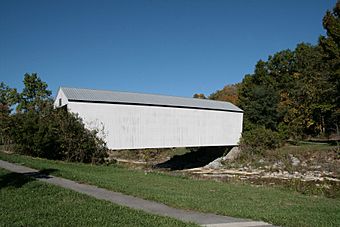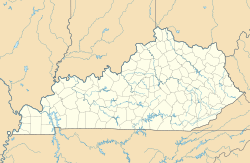Walcott Covered Bridge facts for kids
Quick facts for kids |
|
|
Walcott Covered Bridge
|
|

Walcott Covered Bridge
|
|
| Location | 3.5 miles north of Brooksville, Kentucky on Ky 1159 |
|---|---|
| Built | 1824 |
| Architectural style | Combination King post and Queen post design |
| NRHP reference No. | 75000738 |
| Added to NRHP | June 10, 1975 |
The Walcott Covered Bridge is a historic bridge in Bracken County, Kentucky. It was once a key part of Kentucky Highway 1159, crossing Locust Creek. This special bridge is known for its unique design and interesting history.
In 1954, a new concrete bridge was built nearby. This meant the old covered bridge was no longer used for daily traffic. Even though it was bypassed, the Walcott Covered Bridge remained an important landmark.
History of the Walcott Covered Bridge
The Walcott Covered Bridge has faced some challenges over the years. In 1997 and 1998, big floods caused serious damage to the bridge. Engineers decided it needed to be moved to a safer spot.
In 2002, the bridge was carefully taken apart and rebuilt. It was moved about 400 feet east of its original location. This move helped protect it from future floods. Today, it stands as a reminder of the past.
How the Bridge Was Built
The Walcott Covered Bridge uses a special building method called a truss system. It combines two types of trusses: the King post and the Queen post.
- A King post truss uses a central vertical post to support the bridge's weight. It looks like a triangle with a post in the middle.
- A Queen post truss uses two vertical posts and a horizontal beam. This creates a stronger, more rectangular shape.
The bridge's sides are completely covered, and its outside is painted white. It is 75 feet long, which is about the length of two school buses. It is built from strong poplar wood and sits on two stone supports.
Why Bridges Were Covered
Have you ever wondered why some old bridges have roofs and walls? There are a few good reasons why bridges like the Walcott Covered Bridge were built this way.
One main reason was to protect the bridge from bad weather. The roof and sides kept the wooden parts of the bridge dry. This stopped the wood from rotting and made the bridge last much longer. It was like giving the bridge its own little house!
Another interesting reason has to do with horses. Horses sometimes got scared when they saw the water flowing underneath an open bridge. Covering the bridge helped them feel safer. They couldn't see the water, so they were more willing to cross.



